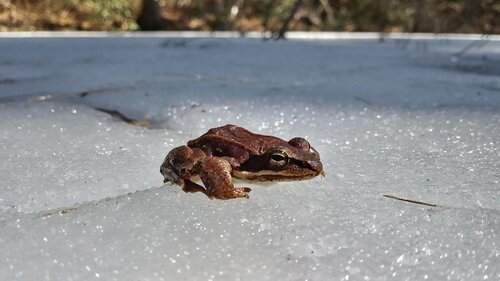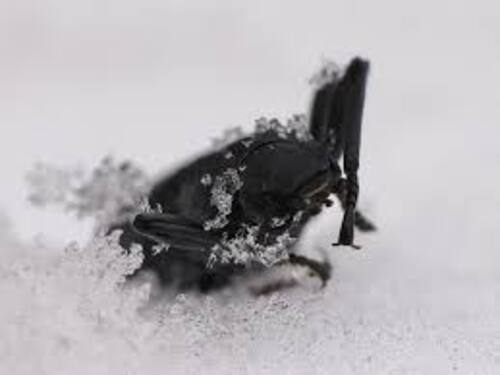Imagine being frozen solid in sub-zero temperatures, only to thaw out and walk away as if nothing happened. It may sound like something out of science fiction, but for some extraordinary animals, surviving freezing temperatures is a natural part of life. From frogs and fish to microscopic creatures, these animals have evolved remarkable survival mechanisms that allow them to withstand being frozen solid for days, months, or even years.
So, what animals can naturally survive being frozen solid? Let’s explore nature’s ultimate cold survivors and uncover the fascinating secrets behind their frosty endurance.
Topping the list of animals that can survive being frozen solid is the wood frog, a small amphibian native to North America. As winter approaches, wood frogs undergo an incredible transformation. When temperatures drop, they stop breathing, their hearts stop beating, and their bodies freeze almost entirely. As much as 70% of the water in their bodies turns to ice, but amazingly, they survive.
The secret to their survival lies in their cells. Wood frogs produce high concentrations of glucose and urea, which act as natural antifreeze. These substances prevent ice crystals from forming inside their cells, protecting vital organs and tissues from damage. In the spring, the frogs thaw out, their hearts start beating again, and they resume their normal lives, hopping around as if they weren’t just frozen solid for months!

The painted turtle, especially the hatchlings, is another animal that can survive freezing temperatures. During the winter months, when the turtles are buried in mud or under ice, they can endure their body fluids freezing. What makes these turtles special is their ability to tolerate anoxia, a state where their body doesn’t need oxygen to survive. They switch to anaerobic respiration, allowing them to live without oxygen for long periods.
The painted turtle’s tissues can survive freezing because they produce chemicals like glucose and lactate, which act as cryoprotectants (substances that protect the body from freezing). This ability allows them to hibernate in ice-covered ponds until the spring thaw arrives.

The woolly bear caterpillar, the larva of the Isabella tiger moth, takes freezing survival to another level. These caterpillars can endure being frozen for months, even in temperatures as low as -90°F (-68°C). As winter approaches, they enter a state of dormancy and allow their bodies to freeze.
What’s remarkable about woolly bear caterpillars is their use of cryoprotectants, specifically glycerol, which prevents ice from forming inside their cells. This adaptation enables them to survive even in Arctic conditions. When spring arrives, they thaw out, resume feeding, and eventually transform into moths.

Living in some of the coldest waters on Earth, the Antarctic icefish has evolved to survive in temperatures that would freeze the blood of most other fish. These fish produce antifreeze glycoproteins that prevent ice crystals from forming in their blood and tissues. This unique adaptation allows them to live in waters that are colder than the freezing point of freshwater.
Unlike many other animals that simply survive freezing, Antarctic icefish actively thrive in these extreme conditions, making them one of the best examples of how life can adapt to the harshest environments.

The Alaskan upis beetle is another extreme survivor of freezing temperatures. Found in the frigid Arctic regions, this beetle can withstand temperatures as low as -60°F (-51°C). The beetle produces a special kind of antifreeze in the form of xylomannan, a molecule that prevents ice from forming inside its cells.
In addition to producing antifreeze, the upis beetle has evolved to tolerate the formation of ice between its cells. This allows the beetle to endure freezing conditions without any damage to its body tissues, making it one of the hardiest insects on the planet.

Tiny but mighty, springtails are minuscule arthropods that can survive freezing temperatures by undergoing a process called cryoprotective dehydration. When temperatures drop, springtails lose water from their bodies, which prevents ice from forming inside their cells. This dehydration allows them to avoid freezing altogether, even in extremely cold environments.
Springtails are found in a wide range of habitats, including the Arctic and Antarctic, where their ability to avoid freezing gives them a major survival advantage.

No list of extreme survivors would be complete without mentioning the incredible tardigrades, also known as water bears. These microscopic creatures are famous for surviving some of the most extreme conditions, including being frozen solid. When exposed to freezing temperatures, tardigrades enter a state called cryptobiosis, where they lose almost all water from their bodies and halt their metabolism.
In this dormant state, tardigrades can survive temperatures as low as -328°F (-200°C). Once they thaw out and are rehydrated, they spring back to life and continue as if nothing happened. Tardigrades are truly one of nature’s most resilient creatures, capable of surviving not just freezing, but also radiation, the vacuum of space, and extreme heat.

The red flat bark beetle, found in cold regions of North America, has evolved to survive freezing by producing antifreeze proteins and cryoprotectants. These substances prevent ice from forming inside its cells, while ice that forms outside the cells is tolerated without causing damage. This beetle can survive being frozen at temperatures as low as -112°F (-80°C), making it one of the toughest cold-weather survivors in the insect world.

The European common lizard, found in northern and central Europe, is unique among reptiles in its ability to survive freezing temperatures. During the winter, this lizard hibernates and can endure its body freezing for short periods. It relies on antifreeze proteins and the ability to tolerate ice formation in its tissues, which protects it from damage during cold spells.

The goldenrod gall fly larva spends the winter inside a frozen plant gall, surviving sub-zero temperatures. Like many other freeze-tolerant animals, the larvae produce glycerol and other cryoprotectants that allow them to survive the freezing of their body fluids. Once spring arrives, the larvae thaw out, pupate, and emerge as adult flies.

Nature has equipped some animals with incredible adaptations to survive freezing solid. From the wood frog’s natural antifreeze to the tardigrade’s cryptobiosis, these creatures demonstrate that life can persist in the most extreme conditions. By producing cryoprotectants or tolerating ice formation in their bodies, these animals have evolved to withstand winter’s harshest challenges.
As climate change impacts the world and temperatures fluctuate, these cold survivors may continue to provide insight into how life can adapt to extreme environments, offering potential applications in medicine, cryopreservation, and space exploration.
So, the next time you feel the chill of winter, remember that somewhere out there, a wood frog is frozen solid, waiting to hop into spring!
animal tags: antifreeze
We created this article in conjunction with AI technology, then made sure it was fact-checked and edited by a Animals Top editor.